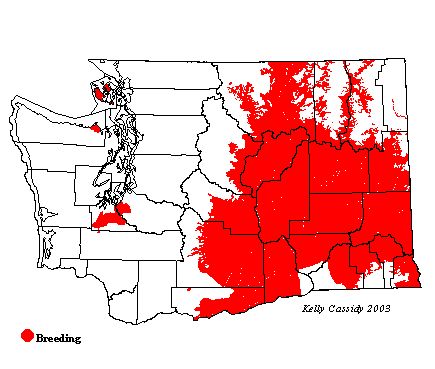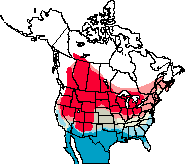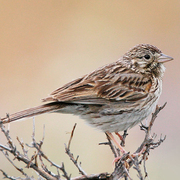Vesper Sparrow
General Description
The Vesper Sparrow is a chunky bird with a finely streaked breast and an unstreaked belly, a short to medium-length notched tail, and white outer tail feathers visible in flight. It has a white eye-ring and a dark ear patch bordered in white along the lower and rear edges. The small chestnut patches on its shoulders are not always visible. Vesper Sparrows west of the Cascades have a pinkish hue and are smaller and browner than eastern Washington birds. Vesper Sparrows are somewhat similar to both the Song and Savannah Sparrows, but are lighter than both. Vesper Sparrows also lack the bold eyeline found in the Savannah Sparrow. Vesper Sparrows are the only nesting sparrows of the open, low valleys of Washington that display white outer tail feathers in flight. This characteristic, along with the chestnut patch occasionally visible on the bend of the wing, distinguishes it from other local sparrows.
Song
Two pairs of slurred whistles, second pair with a higher pitch, followed by a series of short, descending trills. Similar to song sparrow, but with more leisurely opening notes
Habitat
Vesper Sparrows are commonly found in dry grasslands, sagebrush, and agricultural fields at low to moderate elevations. They are uncommon in heavily grazed sagebrush country with little grass cover. These sparrows breed in native shrub-steppe habitats or in small patches of unplowed grass and shrubs near agricultural fields.
Behavior
Vesper Sparrows are often seen in loose flocks before fall migration. They spend most of their time on the ground and take frequent dust baths. Males sing from the highest perches in their territories--often a fence post, shrub, or tree limb. During courtship, the male walks or runs along the ground with his wings raised and his tail spread widely, then periodically rises into the air to give a short flight-song. The female has been known to protect the nest by dragging her leg or wing in a distraction display when threatened. The call is distinctively different from those of the Song Sparrow and the Savannah Sparrow.
Diet
Vesper Sparrows eat mostly insects and the seeds of grasses and weeds.
Nesting
They build a bulky, loose, cup-like nest of grasses and rootlets on the ground in a small depression, often near the base of a grass clump, weed, or shrub. The female typically lays 3-5 eggs in mid-May, and incubates them for 11-13 days. The young fledge in 7-12 days, and pairs commonly raise two broods per season.
Migration Status
Vesper Sparrows winter in the southern to east-central US south to the Gulf Coast and central Mexico. West of the Cascades, birds arrive in early April. The eastern Washington Two subspecies of Vesper Sparrows occur in Washington, divided by the Cascades. The subspecies found west of the Cascades is rare and declining locally. This population is in danger of extirpation in Washington due to conversion of prairies to residential areas, farmland, shrub fields, and forest. The eastern Washington subspecies is common and widespread. Breeding Bird Survey data have shown a statewide increase of 4.4% per year from 1966-1991. Loss of habitat due to development is a potential threat to both subspecies, as are Brown-headed Vesper Sparrows winter in the southern to east-central US south to the Gulf Coast and central Mexico. West of the Cascades, birds arrive in early April. The eastern Washington subspecies arrives in mid-March. Both start to migrate south in mid-September.
Conservation Status
Two subspecies of Vesper Sparrows occur in Washington, divided by the Cascades. The subspecies found west of the Cascades is rare and declining locally. This population is in danger of extirpation in Washington due to conversion of prairies to residential areas, farmland, shrub fields, and forest. The eastern Washington subspecies is common and widespread. Breeding Bird Survey data have shown a statewide increase of 4.4% per year from 1966-1991. Loss of habitat due to development is a potential threat to both subspecies, as are Brown-headed Cowbirds and nest destruction by farm equipment in agricultural areas.
When and Where to Find in Washington
Most occur in the grass, sagebrush, and open Ponderosa pine areas of eastern Washington, but small populations occur in the open prairies around the southern end of Puget Sound and in grassy, weedy areas along salt water. Western Washington populations may be found in Dungeness (Clallam County) (although this population may be extirpated), San Juan Island (San Juan County), the Chambers Lake area, Weir Prairie, and Scatter Creek Wildlife Recreation Area (Pierce and Thurston Counties).
 Abundance
Abundance
| Ecoregion | Jan | Feb | Mar | Apr | May | Jun | Jul | Aug | Sep | Oct | Nov | Dec |
|---|---|---|---|---|---|---|---|---|---|---|---|---|
| Oceanic | ||||||||||||
| Pacific Northwest Coast | ||||||||||||
| Puget Trough | R | R | R | R | R | R | R | |||||
| North Cascades | ||||||||||||
| West Cascades | ||||||||||||
| East Cascades | U | U | U | U | U | U | ||||||
| Okanogan | F | C | C | C | C | C | U | |||||
| Canadian Rockies | U | U | U | U | U | U | ||||||
| Blue Mountains | R | F | F | F | F | F | ||||||
| Columbia Plateau | F | C | C | C | C | C | F |
Washington Range Map

North American Range Map


Family Members
 Green-tailed TowheePipilo chlorurus
Green-tailed TowheePipilo chlorurus Spotted TowheePipilo maculatus
Spotted TowheePipilo maculatus American Tree SparrowSpizella arborea
American Tree SparrowSpizella arborea Chipping SparrowSpizella passerina
Chipping SparrowSpizella passerina Clay-colored SparrowSpizella pallida
Clay-colored SparrowSpizella pallida Brewer's SparrowSpizella breweri
Brewer's SparrowSpizella breweri Vesper SparrowPooecetes gramineus
Vesper SparrowPooecetes gramineus Lark SparrowChondestes grammacus
Lark SparrowChondestes grammacus Black-throated SparrowAmphispiza bilineata
Black-throated SparrowAmphispiza bilineata Sage SparrowAmphispiza belli
Sage SparrowAmphispiza belli Lark BuntingCalamospiza melanocorys
Lark BuntingCalamospiza melanocorys Savannah SparrowPasserculus sandwichensis
Savannah SparrowPasserculus sandwichensis Grasshopper SparrowAmmodramus savannarum
Grasshopper SparrowAmmodramus savannarum Le Conte's SparrowAmmodramus leconteii
Le Conte's SparrowAmmodramus leconteii Nelson's Sharp-tailed SparrowAmmodramus nelsoni
Nelson's Sharp-tailed SparrowAmmodramus nelsoni Fox SparrowPasserella iliaca
Fox SparrowPasserella iliaca Song SparrowMelospiza melodia
Song SparrowMelospiza melodia Lincoln's SparrowMelospiza lincolnii
Lincoln's SparrowMelospiza lincolnii Swamp SparrowMelospiza georgiana
Swamp SparrowMelospiza georgiana White-throated SparrowZonotrichia albicollis
White-throated SparrowZonotrichia albicollis Harris's SparrowZonotrichia querula
Harris's SparrowZonotrichia querula White-crowned SparrowZonotrichia leucophrys
White-crowned SparrowZonotrichia leucophrys Golden-crowned SparrowZonotrichia atricapilla
Golden-crowned SparrowZonotrichia atricapilla Dark-eyed JuncoJunco hyemalis
Dark-eyed JuncoJunco hyemalis Lapland LongspurCalcarius lapponicus
Lapland LongspurCalcarius lapponicus Chestnut-collared LongspurCalcarius ornatus
Chestnut-collared LongspurCalcarius ornatus Rustic BuntingEmberiza rustica
Rustic BuntingEmberiza rustica Snow BuntingPlectrophenax nivalis
Snow BuntingPlectrophenax nivalis McKay's BuntingPlectrophenax hyperboreus
McKay's BuntingPlectrophenax hyperboreus

